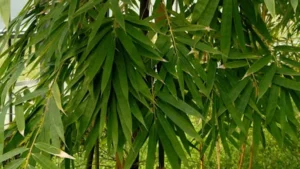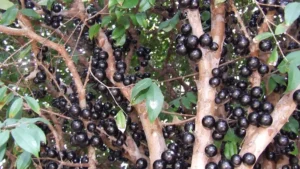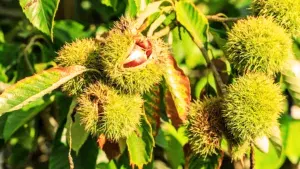Alim Tree
- October 2, 2024
- 0 comment
Alim (Melanolepis multiglandulosa) is a deciduous tree native to Southeast Asia, particularly found in the Philippines and parts of tropical Asia. This tree plays a vital role in local ecosystems due to its ability to thrive in a wide range of environmental conditions, often growing in secondary forests and disturbed areas. Characterized by its broad leaves, rough bark, and small flowers, Alim is known not only for its ecological contributions but also for its traditional medicinal uses. In many indigenous communities, various parts of the Alim tree are utilized to treat ailments such as stomachaches, skin infections, and inflammation. Recent scientific studies have begun to explore the bioactive compounds in Alim, confirming its potential medicinal benefits.

Ecologically, the tree contributes to soil health by preventing erosion and providing shade for understory plants, making it a valuable species for agroforestry and biodiversity conservation efforts. Despite its wide range, Alim faces threats from deforestation and habitat loss, which put pressure on its natural populations. However, its adaptability and economic potential for sustainable harvest offer promising avenues for conservation. As interest grows in integrating traditional knowledge with modern conservation strategies, Alim is increasingly recognized for its environmental, medicinal, and economic significance.
| Specification | Details |
| Scientific Name | Melanolepis multiglandulosa |
| Common Name | Alim Tree |
| Family | Euphorbiaceae |
| Native Range | Southeast Asia, particularly in the Philippines |
| Tree Type | Deciduous |
| Height | Typically 10 to 15 meters |
| Leaf Description | Broad, heart-shaped leaves, bright green color |
| Bark | Rough, brown or gray in texture |
| Flowers | Small, clustered flowers, typically greenish |
| Fruit | Small, round, and contains seeds |
| Preferred Habitat | Secondary forests, disturbed areas, lowlands |
| Soil Type | Well-drained, loamy or clayey soils |
| Ecological Role | Soil erosion control, biodiversity support |
| Traditional Uses | Medicinal, treating stomach issues, skin ailments |
| Threats | Deforestation, habitat loss |
| Conservation Status | Not currently classified as endangered |
| Economic Importance | Potential for medicinal use, agroforestry |
Botanical Characteristics of Alim Tree
The Alim tree (Melanolepis multiglandulosa) is a deciduous tree native to Southeast Asia, particularly abundant in the Philippines and neighboring tropical regions. It typically reaches a height of 10 to 15 meters, with a rough, brownish-gray bark that provides a stark contrast to its vibrant green foliage. The leaves are broad, heart-shaped, and simple, growing in an alternate pattern along the branches. These leaves are soft to the touch, with prominent veins and toothed edges, contributing to the tree’s lush appearance. Alim produces small, clustered flowers, usually greenish in color, that are less conspicuous but essential for its reproductive process.
The tree’s reproductive habits rely on seed production. Alim’s seeds are enclosed in small, round fruits that facilitate seed dispersal primarily through wind and animals. The seeds are lightweight, allowing them to travel considerable distances, aiding in the tree’s ability to colonize new areas. Alim thrives in secondary forests, often preferring well-drained, loamy soils and growing in disturbed or regenerating habitats. It is an adaptable species, capable of growing in both lowland forests and more mountainous regions, making it a valuable plant for restoration projects and agroforestry systems.
Traditional and Medicinal Uses of Alim
Alim holds significant cultural and historical value, particularly among indigenous communities in Southeast Asia. For centuries, various parts of the tree have been used in traditional medicine, with its leaves, bark, and roots employed to treat a variety of ailments. The leaves, when boiled or crushed, are commonly used as a remedy for stomach pains, diarrhea, and skin infections. The bark is sometimes applied as a poultice to treat wounds and inflammatory conditions. Alim’s versatility in traditional healing has made it an important plant in the herbal medicine practices of many local cultures.
Modern scientific research has started to explore the potential of Melanolepis multiglandulosa for medicinal purposes. Early studies suggest that the tree may contain bioactive compounds with anti-inflammatory, antibacterial, and antioxidant properties. These findings reinforce the traditional uses of Alim, pointing to its potential for further exploration in modern medicine. Continued research is needed to better understand the tree’s full range of pharmacological benefits and its potential for development into therapeutic applications.
Role of Alim in Agroforestry and Biodiversity
Alim plays an important role in agroforestry and biodiversity conservation. Its ability to thrive in diverse environmental conditions makes it a valuable species for agroforestry practices, where it is used to improve soil health and prevent erosion. The deep-rooted nature of the tree stabilizes soil, while its broad canopy provides shade, reducing water loss and protecting the understory vegetation. In agroforestry systems, Alim can be integrated with crops and other trees to create sustainable, multi-functional landscapes that enhance productivity while preserving the environment.
Moreover, Alim supports local biodiversity by providing habitat and food sources for a wide range of wildlife, including birds, insects, and small mammals. The tree’s fruits are eaten by various animals, which in turn help with seed dispersal, contributing to the natural regeneration of forested areas. The flowers attract pollinators, playing a role in the ecological balance of the ecosystems where it grows. Alim’s contributions to biodiversity make it a key component of restoration efforts in degraded forest areas.
Conservation Status and Threats to Alim
As of now, Alim is not classified as endangered, but it faces growing threats from deforestation, habitat loss, and climate change. Large-scale clearing of forests for agriculture, urbanization, and logging has resulted in the destruction of its natural habitats, reducing the populations of Alim in the wild. In regions where forests are rapidly disappearing, the long-term survival of the species could become a concern if conservation measures are not implemented.
Efforts to conserve Alim populations include reforestation projects and sustainable forest management programs that emphasize the importance of maintaining biodiversity. In addition, raising awareness about the tree’s ecological and medicinal value is critical for its preservation. Encouraging local communities to protect and sustainably use Alim can help ensure that the species continues to thrive in the face of environmental pressures.
Economic Importance of Alim
Alim holds potential economic value for local communities, primarily through its use in traditional medicine and its role in sustainable land management. While it is not commonly harvested for timber, the tree’s medicinal properties have made it a valuable resource for natural health products. There is growing interest in exploring the commercial cultivation of Alim for these purposes, especially as demand for natural remedies and herbal supplements increases globally.
In addition to its medicinal uses, Alim can be integrated into agroforestry systems, providing benefits for small-scale farmers by improving soil health and increasing crop yields. The tree’s ability to thrive in degraded or secondary forests also makes it suitable for reforestation projects, where it can be used to rehabilitate deforested areas and restore ecological balance. As more emphasis is placed on sustainable forestry and green economies, Alim offers opportunities for both environmental conservation and economic development.
Future Prospects and Research Opportunities
The future of Alim is promising, with emerging research highlighting its potential in various fields. In addition to its medicinal properties, the tree’s role in ecosystem restoration and sustainable land management presents exciting opportunities for further exploration. Alim’s adaptability makes it a candidate for reforestation projects aimed at climate adaptation, as it can help restore degraded landscapes and improve resilience to climate change.
Further research is needed to fully understand the ecological, medicinal, and economic value of Melanolepis multiglandulosa. Areas of interest include the potential for large-scale cultivation, the development of new medicinal products, and its role in enhancing biodiversity in agroforestry systems. By continuing to study and promote the benefits of Alim, scientists and conservationists can help ensure its continued contribution to both human well-being and environmental sustainability.
Different Species
Melanolepis vitifolia – This species is less well-known and is primarily found in Southeast Asian tropical regions, similar to Melanolepis multiglandulosa.
Frequently Asked Questions (FAQs)
1. What is the Alim tree and where is it found?
The Alim tree (Melanolepis multiglandulosa) is a deciduous tree native to Southeast Asia, particularly in the Philippines. It typically grows in secondary forests and disturbed areas.
2. What are the physical characteristics of the Alim tree?
The Alim tree can reach a height of 10 to 15 meters, with broad, heart-shaped leaves, rough bark, and small, clustered greenish flowers. It produces small round fruits containing seeds.
3. What are the traditional and medicinal uses of the Alim tree?
Traditionally, Alim is used in indigenous medicine for treating stomach pains, skin infections, and inflammation. Its leaves and bark are used in various remedies, and modern research is exploring its potential medicinal properties.
4. How does the Alim tree contribute to agroforestry and biodiversity?
The Alim tree helps improve soil health by preventing erosion and providing shade for crops. It supports local biodiversity by providing habitat and food for wildlife such as birds and insects. It is also a valuable species in agroforestry systems for sustainable land management.
5. How does the Alim tree reproduce?
The Alim tree reproduces through seeds contained in small fruits. These seeds are dispersed by wind and animals, allowing the tree to spread across forested areas.
6. What threats does the Alim tree face?
The Alim tree is threatened by deforestation, habitat loss, and climate change, which reduce its natural habitat. While not classified as endangered, it could face conservation challenges if its habitat continues to diminish.
7. Is the Alim tree economically important?
Yes, the Alim tree has economic value, particularly in traditional medicine. It also has potential for commercial cultivation and sustainable harvesting, and plays an important role in agroforestry systems.
8. What is the conservation status of the Alim tree?
The Alim tree is not currently classified as endangered. However, ongoing habitat loss and environmental pressures could affect its populations if conservation efforts are not implemented.
9. Can the Alim tree be used in reforestation projects?
Yes, the Alim tree is well-suited for reforestation and restoration projects due to its ability to thrive in degraded environments. It contributes to soil stabilization and biodiversity, making it an excellent choice for ecological restoration.
10. What are the future research opportunities for the Alim tree?
Future research on the Alim tree includes exploring its full medicinal potential, understanding its role in climate adaptation and biodiversity conservation, and investigating its commercial viability in sustainable forestry practices.














Leave your comment